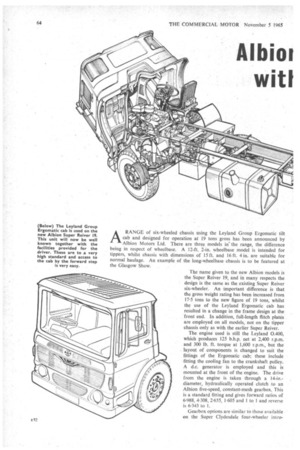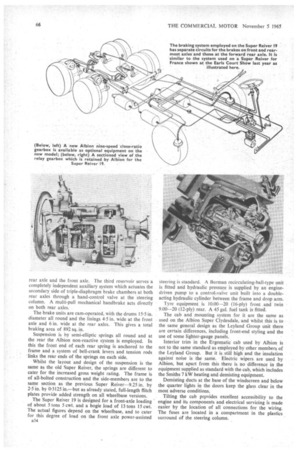19-ton-gross Six-wheeler Ergomatic Gab
Page 67

Page 66

Page 68

If you've noticed an error in this article please click here to report it so we can fix it.
RANGE of six-wheeled chassis using the Leyland Group Ergomatic tilt cab and designed for operation at 19 tons gross has been announced by Albion Motors Ltd. There are three models in the range, the difference being in respect of wheelbase. A 12-ft. 2-in, wheelbase model is intended for tippers, whilst chassis with dimensions of 15 ft. and 16 ft. 4in. are suitable for normal haulage. An example of the long-wheelbase chassis is to be featured at the Glasgow Show.
The name given to the new Albion models is the Super Reiver 19, and in many respects the design is the same as the existing Super Reiver six-wheeler. An important difference is that the gross weight rating has been increased from 17.5 tons to the new figure of 19 tons, whilst the use of the Leyland Ergomatic cab has resulted in a change in the frame design at the front end. In addition, full-length flitch plates are employed on all models, not on the tipper chassis only as with the earlier Super Reiver.
The engine used is still the Leyland 0.400, which produces 125 b.h.p. net at 2,400 r.p.m. and 300 lb. ft. torque at 1,600 r.p.m., but the layout of components is changed to suit the fittings of the Ergomatic cab; these include fitting the cooling fan to the crankshaft pulley. A d.c. generator is employed and this is mounted at the front of the engine. The drive from the engine is taken through a 14-in.diameter, hydraulically operated clutch to an Albion five-speed, constant-mesh gearbox. This is a standard fitting and gives forward ratios of 6.988, 4.308, 2.655, 1.605 and 1 to 1 and reverse is 6.343 to I.
Gearbox options are similar to those available on the Super Clydesdale four-wheeler intro duced last year. They include an overdrive six-speed unit with the same ratios as the five-speed plus an overdrive of 0-76 to 1 (obtained by the addition of extra gearing at the rear of the box), and a crawler/splitter unit with additional gearing at the front of the box. This provides an extra-low first ratio of 9-352 to 1 and reverse of 8.487 to 1. The extra gear train gives a reduction of 1.338 to 1 and can be used to " split " the ratios to make 10 speeds in all.
As well as these a new splitter gearbox, type GB.248, has been introduced for the Super Reiver 19, which provides a range of nine close-ratio forward speeds. This unit will he available for other Albion models and is based on the existing five-speed unit with the indirect ratios stepped up.
The layout is the same as the existing crawlerisplitter unit with extra gearing at the front of the box, and whilst this can be used for all ratios in the main unit, high-fourth is virtually the same as the top, direct ratio, so there are only nine effective forward ratios. These are 8.1, 6-04, 4.994, 3.739, 3.078, 2.304, 1.861, 1.393 and 1 to 1. High reverse is 5-503 to 1 and low reverse is 7-35 to 1. The even spacing between the ratios will be most beneficial on slight motorway-type gradients and the changes for the main and auxiliary sections of the box are carried out by using separate gear-change levers.
Like the earlier Super Reiver, the drive to the rear axles goes tb,rough a relay gearbox which incorporates a lockable third differential. From here separate shafts take the drive to each rear axle. These are of the spiral-bevel type with secondary reduction in the hubs and are to the same design as those used on the Super Reiver. Ratios available are 6-933, 7.428 and 7.712 to I.
Although the new Super Reiver 19 does not come under the new Construction and Use Regulations which require main and secondary braking systems, these are provided on the model. The layout follows the same general idea as that used on the Super Clydesdale and is similar to the brake system used on a Super Reiver for France exhibited at the last Earls Court Commercial Motor Show.
There are three air reservoirs, two of them feeding a dual-type brake-pedal valve, one supplying the brake lines to the foremost rear axle, the other supplying the other rear axle and the front axle. The third reservoir serves a completely independent auxiliary system which actuates the secondary. side of triple-diaphragm brake chambers at both rear axles through a hand-control valve at the steering column. A multi-pull mechanical handbrake acts directly on both rear axles.
The brake units are cam-operated, with the drums 15.5 in. diameter all round and the linings 4-5 in. wide at the front axle and 6 in. wide at the rear axles. This gives a total braking area of 892 sq. in.
Suspension is by semi-elliptic springs all round and at the rear the Albion non-reactive system is employed. In this the front end of each rear spring is anchored to the frame and a system of bell-crank levers and tension rods links the rear ends of the springs on each side.
Whilst the layout and design of the suspension is the same as the old Super Reiver, the springs are different to cater for the increased gross weight rating. The frame is of all-bolted construction and the side-members are to the same section as the previous Super Reiver-9.25 in. by 2.5 in. by 0.3125 in.—but as already stated, full-length flitch plates provide added strength on all wheelbase versions.
The Super Reiver 19 is designed for a front-axle loading of about 5 tons 5 cwt. and a bogie load of 13 tons 15 cwt. The actual figures depend on the wheelbase, and to cater for this degree of load on the front axle power-assisted B34 steering is standard. A Burman recirculating-ball-type unit is fitted and hydraulic pressure is supplied by an enginedriven pump to a control-valve unit built into a doubleacting hydraulic cylinder between the frame and drop arm.
Tyre equipment is 10.00-20 (16-ply) front and twin 9.00-20 (12-ply) rear. A 45 gal. fuel tank is fitted.
The cab and mounting system for it are the same as used on the Albion Super Clydesdale, and whilst this is to the same general design as the Leyland Group unit there are certain differences, including front-end styling and the use of some lighter-gauge panels.
Interior trim in the Ergomatic cab used by Albion is not to the same standard as employed by other members of the Leyland Group. But it is still high and the insulation against noise is the same. Electric wipers are used by Albion, but apart from this there is no difference in the equipment supplied as standard with the cab, which includes the Smiths 7 kW heating and demisting equipment.
Demisting ducts at the base of the windscreen and below the quarter lights in the doors keep the glass clear in the most adverse conditions.
Tilting the cab prpvides excellent accessibility to the engine and its components and electrical servicing is made easier by the location of all connections for the wiring. The fuses are located in a compartment in the plastics surround of the steering column.




















































































































